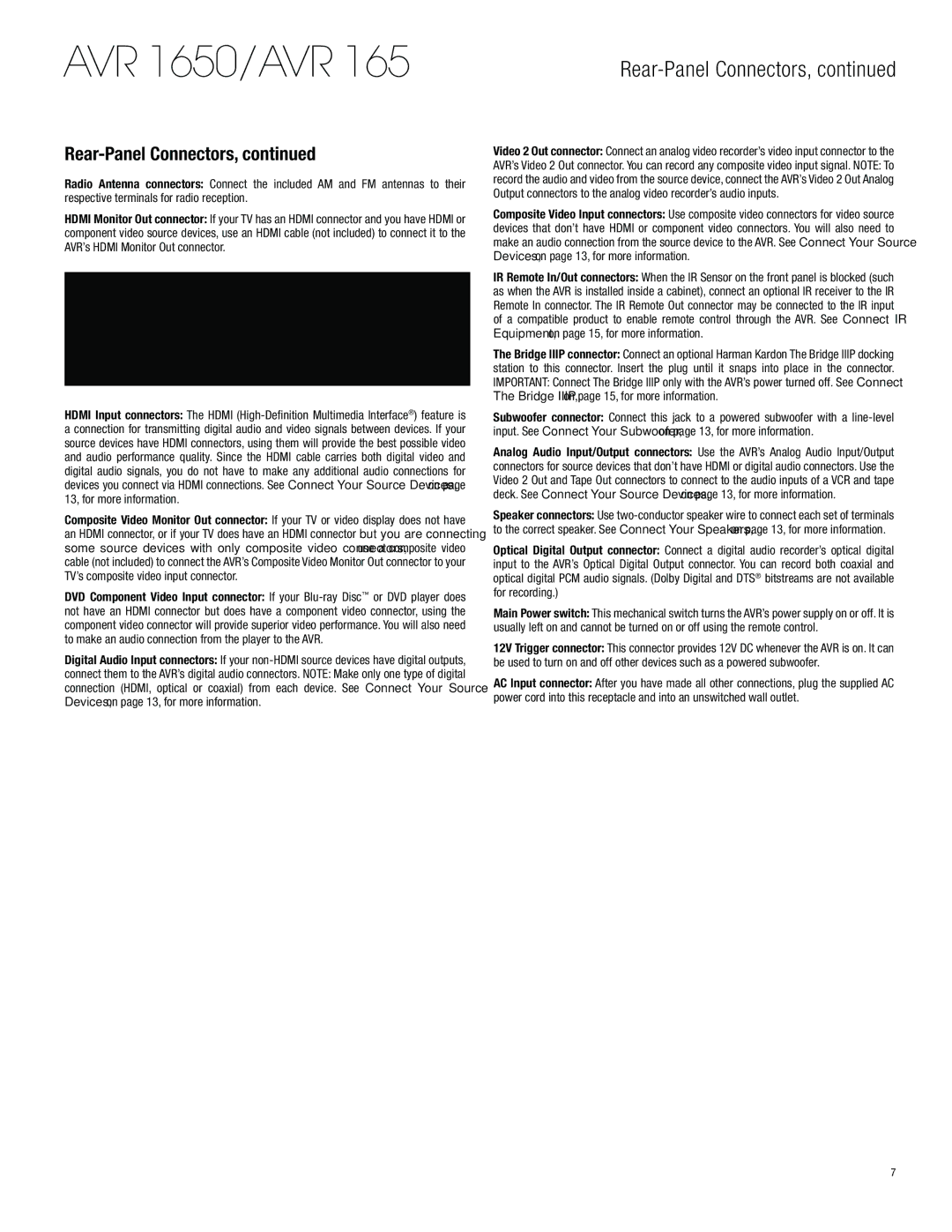
AVR 1650/AVR 165
Rear-Panel Connectors, continued
Rear-Panel Connectors, continued
Radio Antenna connectors: Connect the included AM and FM antennas to their respective terminals for radio reception.
HDMI Monitor Out connector: If your TV has an HDMI connector and you have HDMI or component video source devices, use an HDMI cable (not included) to connect it to the AVR’s HDMI Monitor Out connector.
Notes on using the HDMI Monitor Out connector:
•When connecting a
•Make sure the
HDMI Input connectors: The HDMI
Composite Video Monitor Out connector: If your TV or video display does not have an HDMI connector, or if your TV does have an HDMI connector but you are connecting some source devices with only composite video connectors, use a composite video cable (not included) to connect the AVR’s Composite Video Monitor Out connector to your TV’s composite video input connector.
DVD Component Video Input connector: If your
Digital Audio Input connectors: If your
connect them to the AVR’s digital audio connectors. NOTE: Make only one type of digital connection (HDMI, optical or coaxial) from each device. See Connect Your Source Devices, on page 13, for more information.
Video 2 Out connector: Connect an analog video recorder’s video input connector to the
AVR’s Video 2 Out connector. You can record any composite video input signal. NOTE: To record the audio and video from the source device, connect the AVR’s Video 2 Out Analog Output connectors to the analog video recorder’s audio inputs.
Composite Video Input connectors: Use composite video connectors for video source devices that don’t have HDMI or component video connectors. You will also need to make an audio connection from the source device to the AVR. See Connect Your Source Devices, on page 13, for more information.
IR Remote In/Out connectors: When the IR Sensor on the front panel is blocked (such as when the AVR is installed inside a cabinet), connect an optional IR receiver to the IR Remote In connector. The IR Remote Out connector may be connected to the IR input of a compatible product to enable remote control through the AVR. See Connect IR Equipment, on page 15, for more information.
The Bridge IIIP connector: Connect an optional Harman Kardon The Bridge IIIP docking station to this connector. Insert the plug until it snaps into place in the connector. IMPORTANT: Connect The Bridge IIIP only with the AVR’s power turned off. See Connect The Bridge IIIP, on page 15, for more information.
Subwoofer connector: Connect this jack to a powered subwoofer with a
Analog Audio Input/Output connectors: Use the AVR’s Analog Audio Input/Output connectors for source devices that don’t have HDMI or digital audio connectors. Use the Video 2 Out and Tape Out connectors to connect to the audio inputs of a VCR and tape deck. See Connect Your Source Devices, on page 13, for more information.
Speaker connectors: Use
Optical Digital Output connector: Connect a digital audio recorder’s optical digital input to the AVR’s Optical Digital Output connector. You can record both coaxial and optical digital PCM audio signals. (Dolby Digital and DTS® bitstreams are not available for recording.)
Main Power switch: This mechanical switch turns the AVR’s power supply on or off. It is usually left on and cannot be turned on or off using the remote control.
12V Trigger connector: This connector provides 12V DC whenever the AVR is on. It can be used to turn on and off other devices such as a powered subwoofer.
AC Input connector: After you have made all other connections, plug the supplied AC power cord into this receptacle and into an unswitched wall outlet.
7
